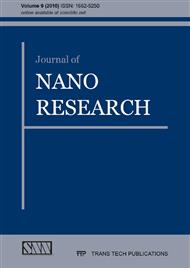p.1
p.17
p.25
p.31
p.39
p.45
p.55
p.61
p.69
Formation of SiOF Films by APCVD Using TEOS-O3-HF Gas Mixture
Abstract:
Fluorinated silicon oxide (SiOF) films have been prepared in a conventional atmospheric pressure chemical vapor deposition (APCVD) reactor. APCVD technique utilizes tetraethoxysilane, ozone and hydrofluoric anhydride as gas sources. SiOF films are deposited by changing the temperature of deposit. Substrate holder was maintained in the temperature range of 200 to 275°C. Films were characterized based on the deposition temperature. Chemical bonding structure of the films was evaluated by Fourier transform infrared spectroscopy (FTIR), Raman spectroscopy and ellipsometry techniques. FTIR spectra revealed Si-F bond at about 935 cm-1. Incorporation of fluorine has a minimal contribution in the reduction of refractive index of SiOF films from 1.46 to 1.35.Therefore, the main mechanism responsible for this reduction of refractive index is the porosity generated by incorporation of fluorine atom in the SiOF films. Dielectric constant was reduced from 4.2 corresponding to that of SiO2 films, to the values in the range of 3.18 to 3.6 for SiOF films deposited by APCVD technique.
Info:
Periodical:
Pages:
39-43
Citation:
Online since:
February 2010
Price:
Сopyright:
© 2010 Trans Tech Publications Ltd. All Rights Reserved
Share:
Citation:


